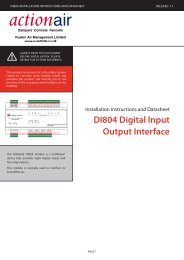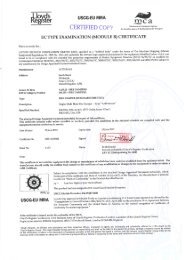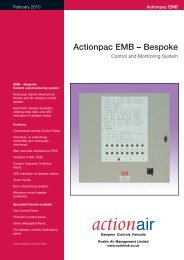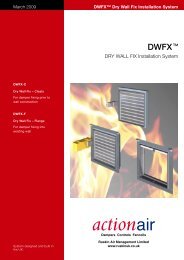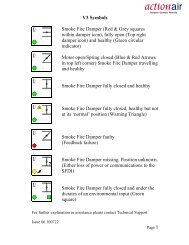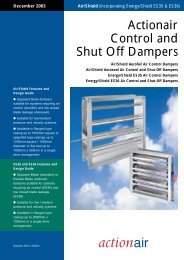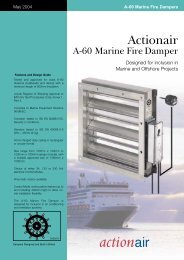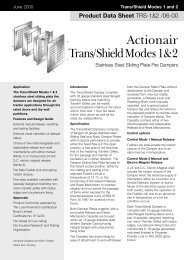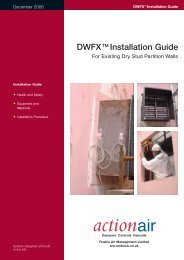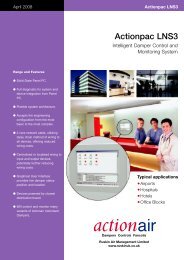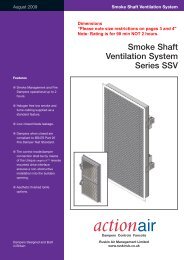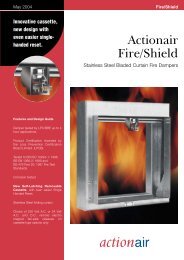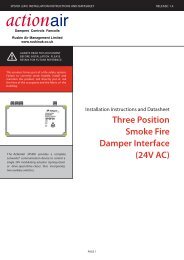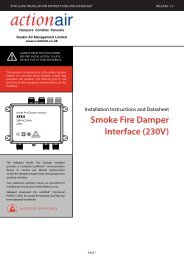A60 Marine Fire Smoke Damper - Actionair
A60 Marine Fire Smoke Damper - Actionair
A60 Marine Fire Smoke Damper - Actionair
You also want an ePaper? Increase the reach of your titles
YUMPU automatically turns print PDFs into web optimized ePapers that Google loves.
A-60 <strong>Marine</strong> <strong>Fire</strong> <strong>Damper</strong><br />
Introduction<br />
Specification<br />
<strong>Actionair</strong> has, for many years, been<br />
associated in the design,<br />
development and manufacture of life<br />
safety equipment, including the<br />
supply of fire damper products to the<br />
offshore and marine industry. The<br />
<strong>Actionair</strong> A-60 <strong>Marine</strong> <strong>Fire</strong> <strong>Damper</strong><br />
has been specifically engineered to<br />
meet stringent legislation.<br />
The A-60 <strong>Marine</strong> <strong>Fire</strong> <strong>Damper</strong><br />
compliments the comprehensive<br />
range of automatic fire and smoke<br />
dampers and associated controls,<br />
provides the complete solution for<br />
shipboard air conditioning and<br />
ventilation systems fire safety<br />
engineering strategies.<br />
The A-60 <strong>Marine</strong> <strong>Fire</strong> <strong>Damper</strong> has<br />
been designed for inclusion in air<br />
conditioning and ventilation systems,<br />
in dry filtered air, and is tested and<br />
approved for fitting to class A-60<br />
divisions (bulkheads and decks),<br />
when suitably insulated (refer to<br />
insulation details).<br />
The <strong>Actionair</strong> A-60 <strong>Marine</strong> <strong>Fire</strong><br />
<strong>Damper</strong> is constructed from<br />
galvanised steel 1.2mm thick, (2 and<br />
3mm options available), 40mm<br />
flanged rectangular or circular casing.<br />
All certificates are<br />
available via the<br />
<strong>Actionair</strong> website.<br />
www.actionair.co.uk<br />
Electrical<br />
The <strong>Actionair</strong> direct-coupled spring return<br />
fail-safe electrical control modes are fitted<br />
with halogen free low smoke and fume<br />
electrical cable. They have a 60 second reset<br />
time and a 20 second release time. Each<br />
actuator has a 72°C rated Electrical Thermal<br />
Release (ETR). The ETR incorporates a<br />
safety electrical interlock that only permits<br />
actuator operation when correctly fitted. A<br />
green 'Healthy' indication lamp is built into<br />
the ETR housing to give a simple and clear<br />
visual check that the actuator is receiving<br />
power, the ETR is correctly fitted, and the<br />
thermal fuse is intact. A manual test switch<br />
allowing periodic operation of the damper for<br />
testing purposes simulates actual fail-safe<br />
release under smoke/fire conditions. End<br />
switches are provided with each mode for<br />
reset and release monitoring.<br />
Electrical ATEX (Ex) rated<br />
The <strong>Actionair</strong> direct-coupled spring return<br />
fail-safe ATEX (Ex) electrical control modes<br />
are fitted with 1 metre of cable for<br />
connection inside hazardous areas.<br />
They have the benefit of a Universal<br />
electrical supply using any Voltage between<br />
24-230V AC/DC, which is self adaptable.<br />
They have Variable (3 -15-30-60-120 sec)<br />
Reset and (3 -10 sec ) Release times, which<br />
are selectable on site. Each actuator has a<br />
Integral Safety Temperature Sensor (ExPro-<br />
TT) rated at 72 °C. The ExPro-TT<br />
incorporates a triple fail-safe thermal fuse<br />
arrangement, 2 induct and one outside, to<br />
ensure the fail-safe actuator operates in all<br />
conditions. A manual test switch allowing<br />
periodic operation of the damper for testing<br />
purposes simulates actual fail-safe release<br />
under smoke/fire conditions. End switches<br />
are provided with each mode for reset and<br />
release monitoring. An Integral heater allows<br />
the unit to be operated within ambient<br />
temperatures down to – 40°C.<br />
Pneumatic ATEX (Ex) rated<br />
The <strong>Actionair</strong> direct coupled spring return<br />
fail-safe pneumatic control mode requires an<br />
air pressure of between 5 to 8 bar (72 to<br />
116 psi) to operate. They have 3 second<br />
reset and release time. Each actuator has a<br />
Pneumatic Thermal Release (PTR). The PTR<br />
assembly is supplied with 500mm nylon<br />
tubing that connects to the quick fit<br />
couplings of the PTR and actuator.<br />
Incorporated is a fail-safe 74 °C fusible link.<br />
When this operates, air exhausts from the<br />
actuator, permitting the spring return<br />
actuator to go to the fail-safe position, thus<br />
closing the damper. Switch box and<br />
solenoid accessories are available for<br />
monitoring and control.<br />
Testing - Maintenance and cleaning<br />
A-60 <strong>Damper</strong>s are supplied in 2 casing and<br />
blade options:-<br />
1. 430 Standard steel blades, Galvanised<br />
Steel casing - only suitable for installation in<br />
dry filtered systems.<br />
2. 316 Standard steel blades, casing and<br />
drive - more suited for corrosive conditions,<br />
but even this will rapidly corrode and fail if<br />
not properly maintained, when used in air<br />
intake systems at sea. The addition of a<br />
mist eliminator is highly recommended and<br />
access must be provided for maintenance.<br />
Pay particular attention to the blade rivets,<br />
where crevice corrosion will cause rapid<br />
failure of blades if not kept in check.<br />
Testing<br />
Two levels of testing exists.<br />
1. Routine testing<br />
Monthly, or in accordance with<br />
maintenance programme, release and reset<br />
damper (via control system or ETR test<br />
switch). Check remote indication or visual<br />
check of mechanical pointer as appropriate.<br />
2. Visual check at damper<br />
At commissioning and at least once a year,<br />
check damper operation by removing and<br />
re-applying power to actuator. (via ETR test<br />
switch). Visually check blades for damper<br />
closed and open positions. Prove remote<br />
indication if applicable.<br />
Routine Maintenance<br />
Depending upon environmental conditions,<br />
each damper will merit its own cleaning<br />
regime. Particularly hostile areas may<br />
require monthly cleaning and lubrication.<br />
‘Frequency of maintenance’ should be<br />
determined by collecting historical data<br />
from previous visits, and for this reason,<br />
commence maintenance programmes at<br />
very frequent intervals. <strong>Damper</strong>s in ‘Dry<br />
Filtered Air’ require very limited<br />
maintenance.<br />
Using Duck Oil (recommended lubricant, or<br />
similar equivalent), clean all exposed<br />
surfaces, using a cloth. Remove all traces<br />
of surface staining, as this will deteriorate<br />
further causing deeper material corrosion.<br />
If damper is stiff to operate, lubricate blade<br />
ends and open and close damper<br />
successively until the damper moves with<br />
ease. (This may necessitate removal of the<br />
actuator and operating the blades manually<br />
by the drive shaft). Refit actuator, and retest.<br />
Clean off excessive lubricant.<br />
2




